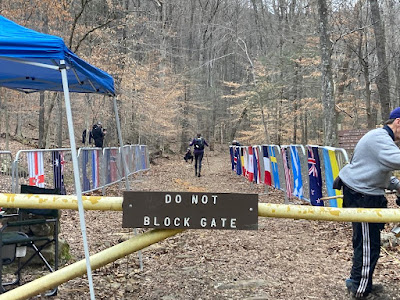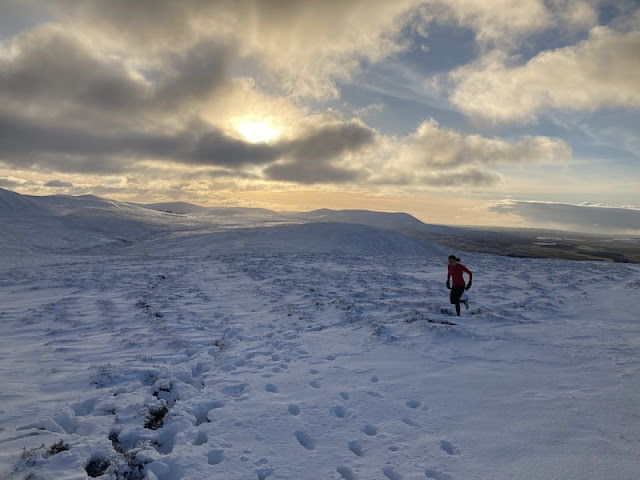‘I understand now why Barkley becomes an
obsession; in fact, I suspect I’m already firmly in its grip’.
My words,
one week after my unsuccessful attempt (‘Fun Run’ completion) at the 2022
Barkley Marathons. By the time I wrote those words, I knew I’d be back, and
imagined myself doing so at the peak of fitness, ready to take on anything. In
the end, my autumn training was dogged by fatigue which forced time to be redirected
from training to sleep, as well as the flare-up of a chronic knee injury, an
MRI of which prompted the orthopaedic specialist to comment, ‘If you want to
carry on running, stick to soft surfaces and avoid anything undulating’. I
didn’t tell him I’d just received a letter of condolences from Laz…
In the end,
thanks to the support of my family and the patience of my coach (Damian Hall),
I managed 6 weeks of solid training in the final run up to Barkley Marathons
2023, and I arrived in Frozen Head excited to see what I could do. This year
there were familiar faces and happy reunions to balance out my nerves, as well
as a fantastic weather forecast for the 3 days ahead. I was convinced the conch
would be blown in the night, so I was surprised to wake up in daylight, having
managed 7-8 hours of sleep. At 8:54 it sounded, and an hour later we were
jogging en-masse away from the yellow gate, into the quiet forest beyond.
 |
| Pre-race chat. Credit: Howie Stern |
Loop 1
(clockwise in daylight, 8 hours 36 minutes) passed surprisingly quickly. The
running felt easier than the previous year, and it was fun to be with other
runners for much of the loop. My dodgy knee made me cautious downhill, and I
wasn’t surprised to lose sight of Damian and John early on. Rat Jaw had been
mown, removing the challenge of the neck-high briars we’d encountered the
previous year. From the prison to the end of the loop I ran alone, but I
managed to follow a reasonable line and lost no time finding the books. I
entered camp to find the group of Jared, Karel, and Joe still present, so I
made a quick turnaround to get out with them for the nighttime loop.
Loop 2
(anticlockwise at night, 12 hours 38 minutes) felt harder, and certainly
colder. I hung on at the back of the group, although I could tell Karel was struggling
a little too (he later posted that he’d been suffering the after-effects of a
stomach bug). Being with others was a real boost, nevertheless we moved more
slowly than we had in daylight and made an error which cost us a little time.
The final two climbs of the loop were rough, and I realized too late that I’d
run out of energy, which resulted in me getting dropped as we started the climb
from book two. I watched the headtorches pull away into the darkness above, as
I slowly clawed my way upwards. A stupid error delayed me at book 1, and I
arrived at camp shortly after Karel and Jared’s departure.
Loop 3
(anticlockwise in daylight, 14 hours 24 minutes). The headtorch I’d started
with was soon unnecessary, and I climbed to Chimney Top in a sky blazing with
pinks. I heard a cheerful shout behind me and turned to see Joe approaching,
refreshed after his brief sleep. We collected our pages, and I wished him good
luck as he pushed on, hoping to catch the two in front. Not long after,
arriving at the next book, I was surprised to find his page still present, and
I wondered fleetingly what adventure he might be having, before turning my
attention back to my own. The climb to the fire-tower felt long and slow, and I
was glad of the cheerful support waiting at the top. I surprised myself by
navigating the next few books with ease, only to get lost on a section of
straightforward trail further on. I was acutely aware of time ticking away, and
I anxiously calculated splits on every summit, hoping to make it back in time
to start loop 4. Between book 2 and book 1, I met Damian and John, then Karel
and Jared, all of whom encouraged me with friendly words, in my quest to reach
camp before the cut-off to start loop 4 (36 hours).
 |
| Credit: Alexis Berg |
Loop 4
(clockwise in nighttime and then daylight, approximately 16 hours 36 minutes).
I took time at the loop 3 to 4 changeover to prepare myself for what I knew
would be a difficult night, alone in the forests of Frozen Head. Having little
more than 12 hours ahead of me to complete the loop, I knew the chances of
getting back in time were low, but I was determined to get as far as I could. I
ate pasta, Sonic™ potato tots (Damian and John’s
leftovers I think!) and chocolate oat milk, and Konrad stuffed my pack with
food I was still able to eat, including cold pizza, roasted salty potatoes,
gels and sweets. I felt oddly elated heading away from the gate, knowing that I
had already made it so far, largely under my own steam. I was rapidly reminded
how fickle success is at Barkley, when I misjudged the start of the descent to
book 2, ending up in a horrible mess of gulleys, crisscrossed with fallen trees
and vine encased boulders. Unbeknown to me, in the time it took to correct my
mistake, I’d been passed by Tomo, making me the last runner on loop 4. As the
night wore on it became harder and harder to stay awake. The steep climbs were
painfully slow, and the sight of leaves and tree trunks was more soothing than
counting sheep could ever be. Trail with switchbacks was even worse, and I
found myself waking up from microsleeps having missed a turn, debating which
way to go. Reaching the ridge at Garden Spot it was suddenly bitterly cold, and
I stopped to put on a padded jacket, just as I’d done the previous night. I
knew I’d slowed down, and tried to force myself to pick up the pace, but it was
so easy to lose focus, in the sleepy darkness. I was glad when the first light
of morning came, as I reached the summit of Stallion Mountain, colouring the
sky with the promise of a spectacular dawn. Much like the final evening on the
Spine race in 2019, I think the dawn on loop 4 of Barkley 2023 will remain with
me forever, it was that beautiful. The morning that followed was cold, bright, and
clean. The fire-tower was quiet and peaceful as I passed by, as if Barkley was
holding its breath in respect of the morning’s splendor. As I reached the
bottom of the descent towards the prison my watch flicked over from 23:59 to
00:00 again, the 48 hours elapsed. I finished the loop by collecting the
remaining pages (I wasn’t aware, or maybe just didn’t recall because of my
sleep deprived state, that I should go straight back at this point. I don’t
think it would have made a big difference anyway – and I’m glad I didn’t find
myself debating it, since it would have been very hard to give up so close to
the end of the loop). The last two climbs were accompanied by a bizarre mixture
of old friends, family members, exotic animals and modern sculpture displays. I
argued repeatedly with those around me that the climb couldn’t possibly be so
long, and found myself amazed that the ground underneath my feet was the only
thing matching what my eyes were telling me. The descent from Chimney Top was
like a slow motion movie without sound, the forest still and warm from the
midday sun, my shuffle through the leaves a distant noise on the outskirts of
my consciousness. At the top of the last small rise, I saw a body lying across
the path in front, but I knew that wouldn’t be real. Nevertheless it remained there as I got closer, until I was standing above it, at which point I
realized it was Damian, asleep. I stood for a moment, then decided I should
probably ask if he intended to be sleeping here. At which point he opened his
eyes looking a bit confused, and asked me with concern ‘Are you ok?’, which
struck me as somewhat ironic, coming from someone lying asleep across the path
in a forest. We proceeded to discuss the location of the final book, which
Damian had been unable to find in his tired state, and he explained to me that
he’d brought back a leaf, and a small rock, to prove he’d been there. Although
on second thoughts, he said, ‘that probably wouldn’t work would it?’, looking
confused again. He continued to tell me that he’d also left two pieces of
biscuit up there, for Laz to know he’d been there. The image of Laz wandering
around Chimney Top searching for biscuit crumbs was amusing, but not out of
place in my muddled thoughts, and I only pondered it briefly, before suggesting
we return to camp together. It was a pleasure to cover those final moments of
Barkley 2023 with a great friend, who did so well on his first attempt at the
course.
When I reached the gate Laz looked at me enquiringly and asked whether I still thought I could do five loops. I looked at him and replied honestly that I thought I could. He smiled.
It was a
great privilege and huge inspiration to witness Aurélien Sanchez, John Kelly
and Karel Sabbe as they each finished the final loop of the Barkley Marathons
and touched the yellow gate for the fifth time. I hope that one day I will do
the same. Until then, I am grateful to have discovered a little more about
myself, amongst the beautiful wilderness of Frozen Head.
My final
thanks go to my family. To Konrad, for your support and for being my best
friend. To my brother Vaclav, Agnese and Miranda, for welcoming us to New York
and making the trip a true holiday. To my parents Alena and Jeff, for caring
for the children whilst we were gone, and especially to my mum, who potty
trained our youngest in the process! I bet there aren’t many Barkley
competitors who have received inter-loopal potty training success updates!
 |
| Credit: Alexis Berg |


























